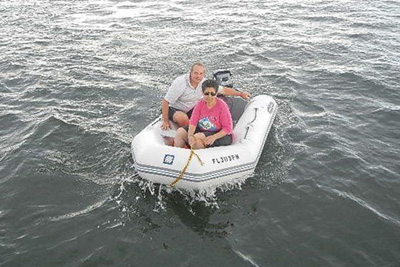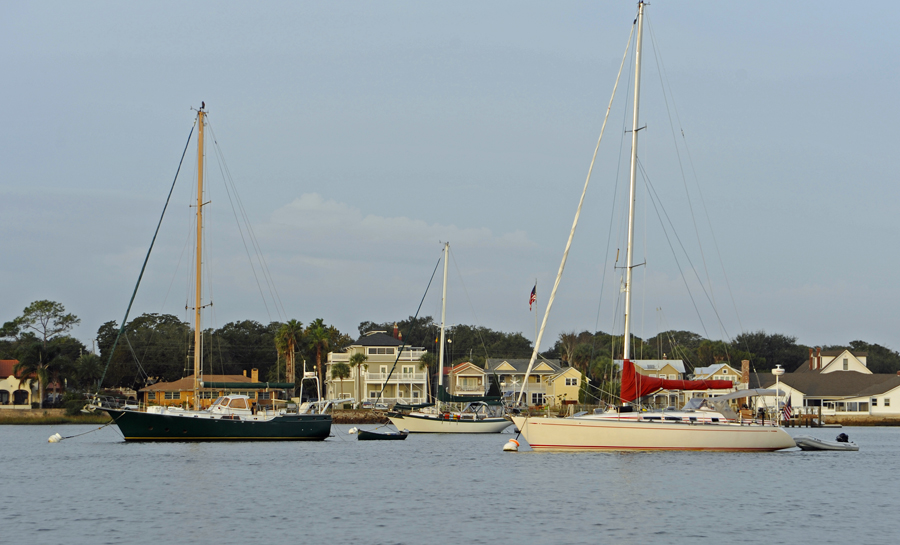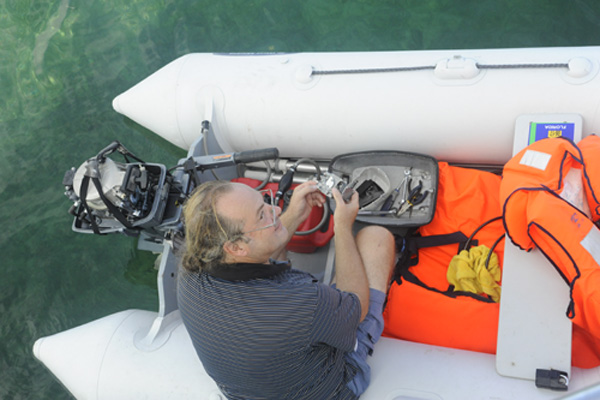We hate our dinghy. Maybe hate is too strong a word but we really, really don’t like it very much. Among other things, it is too small. Once we put a small gasoline tank, oars, life jackets and two people, there is not much room. It is not easy to maneuver and it leaks. It leaks….a lot. Our small outboard engine has it’s issues too. We cannot always count on it starting. We might buy a new dinghy and possibly engine next year. We want to see how much we use one this first year before we make a decision.
Dinghies are a mode of transportation for us. Most sailboats have davits on the back where they stow/hang their dinghy. Some boaters tow their dingy behind their boat just like an RV might tow a car. Some are stored on top of the boat. We don’t have davits. Our dinghy is stored in the lazarette (storage at the back of the boat like a trunk of a car). When we are anchored or on a mooring ball the dinghy is our only way to get to shore. Well, besides swimming.
We have repaired the leak in our dinghy several times. So, I guess “repaired” is not the right word or it would not leak anymore. We have found the reason for the leak. We just have not had time to repair it properly. There have been more pressing matters like repairing the diesel engine, doing laundry and maybe having some fun along the way. Our dinghy repair is on the backburner. We can bail out the dinghy. We can’t go naked or be without a working engine. And besides, we only have to bail the dinghy before, during and after each use.
The ability of a dinghy to plane seems to be really important to a lot of boaters. Whenever dinghies are mentioned the ability to plane comes up in conversation. Our dinghy does not plane. Our dinghy does not go fast enough to plane. Our dinghy is more the “don’t go farther than you want to row back” category.
Whenever we take the dinghy out for a spin I share the driving with Mark. Taking the dinghy out for a spin is a lot of work for us. We drag the dinghy out of the lazarette, first moving and sorting through all the items that we have thrown in on top of the dinghy since last we used it. This usually takes place on one hundred degree days with not a flutter of wind and at least eighty percent humidity.
Once the dinghy is on deck there are five floor boards and two slats to assemble. I know this as a fact as the previous owner of the dinghy numbered the floor boards. He accidentally put the numbers on the top side rather than the bottom of each board. As I sit in the dinghy I can see the numbers on the floor in the areas that are not covered by oars, life jackets, gas can and people.
Once the dinghy is put together and inflated we tie it off and launch it into the water. Mark gets into the dinghy and we start the process of putting the small outboard engine onto the transom of the small boat. I use the ropes and pulleys on the mizzen boom to lower the engine down to Mark who is waiting in the dinghy. The engine is heavy and would be difficult to lower by hand. Picture standing in a small inflatable, unstable, leaking craft being handed a sixty pound engine from over your head. You might picture engine and person both going over backwards into the water. Once the engine is lowered and secured onto the dinghy, we install the gas tank, hand down oars (in case the engine decides to stop working), life vests, VHF radio (for emergencies), cable and lock for securing the dinghy on shore and the all important bailing bucket. We are ready to go. This usually takes a little over an hour to perform. And, usually requires a shower afterwards. Please refer back to 100 degree heat, no wind, 80% humidity.
Mark has taken the dinghy out alone for various reasons from time to time. I have always had a passenger in the dinghy with me when I drive it. This fact will become important later in this post. You’ll see why….
As Mark wrote previously, one of our reasons for visiting Annapolis, Maryland was for him to take a training class on advanced diesel engine repair and maintenance. We decided that we would pick up a mooring buoy in Annapolis rather than stay at a marina or anchor the boat in an anchorage. This would be our first time on a mooring buoy. Picture it, our first time on a mooring and we choose Annapolis to do it. Annapolis; the sailing capital of the Chesapeake Bay; in a tight, crowded mooring field; right in front of the US Naval Academy; with everyone watching. Yeah, this was a good idea. No pressure.
We had a plan. We always have a plan. It makes life and tasks go better to have a plan. Here is the nautical jargon just so the on-lookers know I know what I am doing. There is always jargon: Mark motored the boat toward the mooring buoy. From the bow, I hooked the painter on the first try, clamped it to our bridal that was cleated and ready to go. We were set. High fives all around. It is a good day. Here is the non-nautical jargon for the rest of us: Mark steered the boat toward the big mooring ball while I stood on the front of the boat with my boat pole. I caught the icky, slimy rope that is attached to the big, round, algae covered mooring ball with my boat hook (pole). I then clipped the slimy rope to the “V” shaped ropes tied to the front of the boat. I did this without falling into the water or having to give Mark the universal hand motion to “go around again”. My first try! Success! High fives all around! It was a good day.
Feeling confident we got Old Leaky out of the lazarette and proceeded to pump it up, drop the engine on and go to shore. I was in the driver’s seat of the dinghy getting some practice for the next day. The plan was for me to drive Mark in the dinghy to a public dock each day and drop him off. He would walk to his training class from the public dock. I would return to pick him up at the end of the day. It is more difficult to do this alone without help so we made a practice run for me to get comfortable docking alone. We pretended Mark was not in the dingy for the practice run. Mark was there for moral support to give me pointers and to remind me anything I might forget to do.
I went through the start up procedure for the little engine and proceeded to motor toward the shore. Once I found the dinghy dock I maneuvered through the plethora of other dinghies to find a spot to dock. We tied off the dinghy. Now it was time to do the trip in reverse. All went well. High fives all around! It is a good day.
Morning came; I climbed into the dinghy and proceed to bailed out the water that leaked in during the night. I hold my breath, pull the chock, pull the cord and with fingers crossed the engine fires up. YES! I finished getting the dinghy ready for my passenger. Mark came up on deck, backpack over his shoulder, thermos and packed lunch in his hand. He was ready and excited to go to class. Here we go! Hey, I can do this! Piece of cake!
It was early; the boats floating quietly at their moorings. The only noise being our little engine as we motored along. A few earlybirds were sitting in their cockpits with their first cups of coffee. They waved as we motored past. Once out of the mooring field we motored across the river and over to the public dock. A boat show was just a few weeks away. The fairway to the dock was crowded with boats waiting for the show making the passage quite narrow. I slowed the dinghy, crept up to the dock, Mark caught a cleat on the dock, wrapped the line and hopped out. I waited for Mark to toss me the rope and give the dinghy and myself a little shove off as he waved goodbye. This is where things got interesting.
As I mentioned, I have always had a passenger in the dingy with me. Little did I realize that the weight of the passenger in this small craft would magnify the ever present issue we have maneuvering this tiny boat. My ability to steer the dingy was changed dramatically. With the now missing weight of Mark the dingy was drifting sideways and at an angle down the crowded, narrow fairway.
I saw a couple of swim ladders on the sterns of boats up close and personal. I tried not to panic as I attempted to go straight between the rows of boats. I bounced my shoulder off the stern of one boat saying, “OUCH!! OH! SORRY BOAT! SORRY!” After what seemed an eternity but was probably only a few moments, or the length of a couple of boat slips, I finally found my way. Old Leaky and I started to motor in a sort of straight line. Well, sort of, but definitely straighter and away from the rest of the docked boats. Whew, out of the fairway and onto the river. No damage done to the boats or dinghy. The only damage done was maybe a little chunk of my self-esteem.
On the way back to Cream Puff I had time for some trial and error in order to learn more about managing the direction of the dingy when motoring solo. This time there was a bit of traffic on the river to dodge as I crossed. My tiny wake from the dingy zigged a little this way and then zagged a little that way as I tried out different steering positions. Knowing this would change twice a day when I had Mark as a passenger. Looking over my shoulder at the wake it looked more like I was on my way home from one of the nearby bars after a long night drinking rum punch rather than just dropping hubby off at school.
I found our boat floating safely on the mooring right where we left it. Docking the dinghy proved very different without the passenger weight as well. I cut a little too close and bounced off the side of the hull. I managing to get control but just missed grabbing the handhold on the first try. Falling slightly off the seat, knee first into the accumulating water that had leaked in during my passage.
I circled the boat for a better angle and a second try. The water splashing around my ankles with each turn. Ah, the on lookers are waking up. I have one more try before they gravitate to the bows of their boats, bleary-eyed, coffee in hand to watch the entertainment for the morning—me. I slowly crept up behind Cream Puff, caught the rail—there was no way I was going to miss it a second time—and docked the small, water filled, crappy, rubber craft. With a small sigh, I shut down the engine and bailed the water out. First run done. Seven more to go. All is good but maybe save the high fives for another day.
Later that week Mark took the dingy over to chat with a couple on another Amel who moored near us. The wife said to Mark, “I went up on deck and saw Cindy bailing out the dingy this afternoon. 15 minutes later I went back up and she was still bailing out the dingy”. “Yeah,” Mark replied, “We hate our dinghy.”
UPDATE: In 206 we bought a new dinghy and new outboard motor. https://www.creampuff.us/2016/09/a-new-dinghy/





